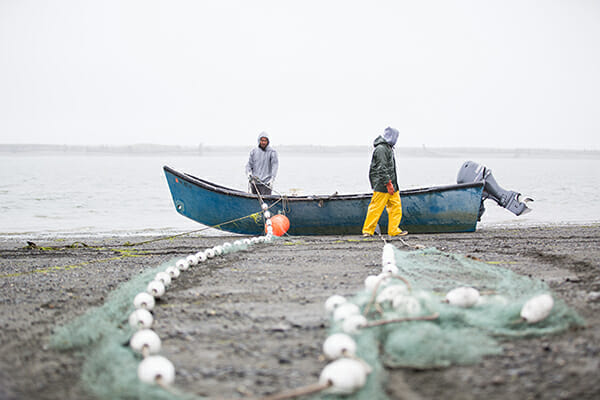As Sealaska’s board finalizes the spring distribution to Sealaska shareholders in a meeting on Friday, April 2, the company’s business operations continue a trend of increasing profitability.

Thanks to the incredible dedication and skill of so many at Sealaska, several of our businesses actually saw record financial results in 2020. Their efforts enabled us to keep our employees safe while supporting our communities and building on our work to strengthen ocean health.
Why ocean health? We are stewards of a company with an important social mission and an opportunity to help make a difference in our world. Salmon are telling us that our warming planet’s systems are out of balance. Humans are on track to double their population on a planet with limited resources. How will we produce more food with less water? How will we restore health for the oceans that have nourished us for thousands of years? How can we help make it all sustainable?
These are global issues, by definition. And they are the biggest challenges facing humanity. That’s why the path forward for our businesses involves investing in work that contributes to health and balance for lands and oceans and addresses the effects of climate change.
Our goal is to do that by enhancing people’s lives through the enjoyment of seafood, and by finding solutions that reverse ocean warming, pollution, and waste. We’re becoming an ocean-sciences company, with a growing ability to research and monitor our environment, clean up human-made messes, and build thriving communities. We’ve been steadily growing our capacity to solve complex problems and support clean–energy generation.
Low-impact foods: Relying on our oceans for nourishment is key to Sealaska’s work. We believe that understanding, respecting and depending on our oceans is central to saving them – and ourselves. Close ties to the ocean are part of the history of Sealaska’s people. This focus is consistent with who we are.
Sealaska’s purchase of New England Seafood International Limited (NESI) in October of 2020 strengthened our business with a well-managed, successful company that has proven its excellence in sustainable sourcing, smart branding and steady growth. We are lending one another valuable new perspectives while appreciating our shared commitment to long-term thinking and respectful use of our planet’s limited resources.
Research and monitor: As the energy economy shifts from a reliance on petroleum products to more renewable sources of power, offshore oil platforms are increasingly idled. Drilling sites need to be cleaned up and made safe for future generations. At the same time, new opportunities are emerging to harness energy with offshore wind and tidal turbines. And rising sea levels will create new problems that call for creative solutions.
CS Marine, which is based in California’s Bay Area, joined the Sealaska family of businesses in June of 2020 as part of those creative solutions. CS Marine specializes in underwater construction, repair, demolition, salvage and maintenance. Customers seek out and respect CS Marine for its consistent ability to take on difficult, complex projects.
The addition of CS Marine builds on the strengths of other Sealaska businesses, including Gregg Drilling and Sealaska Engineering and Applied Sciences, that can conduct seafloor soil sampling, research fisheries, support engineering and other scientific work, and innovate in many ways.
Clean up messes: Human-made pollutants affect much of the world. Contamination and trash – especially plastics – in our oceans harm countless marine species, and contaminants in the ocean work their way up through the food chain to damage human health, too. It’s all connected.
That’s why cleaning up pollutants is an essential part of building a business that’s focused on fostering health and balance for lands and oceans. Sealaska has been carefully growing its capacity to do that.
Gregg Drilling, CS Marine and many parts of our Government Services Division, including Sealaska Environmental Services and Sealaska Technical Services, bring innovation and skill to cleanup work in Alaska, the West Coast, and beyond. In many cases, we’re mitigating chemical contamination in soil, groundwater and marine environments with biological processes that produce no harmful side effects and allow formerly contaminated soil and water to remain in place. We’re monitoring and treating groundwater in places like Adak Island in the Aleutians and Los Alamos, N.M.
Build thriving communities: In 2020, we had the opportunity to serve and uplift our communities in ways we haven’t been called upon to do in our history as a company. Suddenly, everyone was hurting in one way or another. We are grateful that we could help.
In addition to our ongoing shareholder–benefits programs, we quickly deployed more than $1.4 million in COVID-19 emergency relief funding to those in need. Unrestricted funding from Sealaska helped ensure kids and families had access to healthy food when other programs were not available.
Sealaska’s support helped enable delivery of 49,000 pounds of salmon to families, a surf camp for kids, and cultural materials for use in creating art and other projects in homes. We are supporting the development of career pathways and skills training that will provide more opportunities for employment in our rural communities. And we are working with partners such as Sealaska Heritage Institute, the University of Alaska Southeast and the Central Council of Tlingit & Haida Indian Tribes of Alaska to support anyone who is willing to devote the time to learning and perpetuating traditional languages.
The approach we’ve chosen is one that can make a difference in the world. Maybe even more important, it creates opportunities for young people. We are developing pathways to well-paying careers in the sciences, engineering, math and technology close to home while working to improve the health of the lands and ocean they will inherit. We owe that to them. And we owe it to their grandchildren.